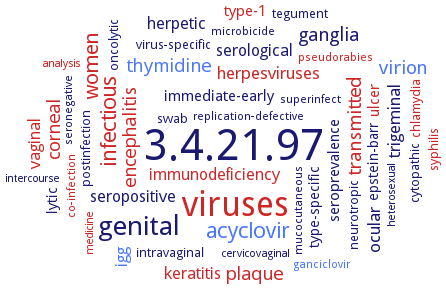3.4.21.97: assemblin
This is an abbreviated version!
For detailed information about assemblin, go to the full flat file.

Word Map on EC 3.4.21.97 
-
3.4.21.97
-
viruses
-
genital
-
acyclovir
-
infectious
-
women
-
ganglia
-
transmitted
-
virion
-
thymidine
-
encephalitis
-
plaque
-
corneal
-
trigeminal
-
ocular
-
herpesviruses
-
keratitis
-
igg
-
herpetic
-
vaginal
-
seropositive
-
immunodeficiency
-
serological
-
immediate-early
-
type-1
-
ulcer
-
seroprevalence
-
type-specific
-
lytic
-
epstein-barr
-
chlamydia
-
tegument
-
neurotropic
-
cytopathic
-
oncolytic
-
syphilis
-
intravaginal
-
swab
-
postinfection
-
virus-specific
-
microbicide
-
replication-defective
-
seronegative
-
co-infection
-
ganciclovir
-
superinfect
-
pseudorabies
-
mucocutaneous
-
analysis
-
intercourse
-
medicine
-
heterosexual
-
cervicovaginal
- 3.4.21.97
- viruses
-
genital
- acyclovir
- infectious
- women
- ganglia
- transmitted
- virion
- thymidine
- encephalitis
- plaque
- corneal
-
trigeminal
-
ocular
- herpesviruses
- keratitis
- igg
-
herpetic
- vaginal
-
seropositive
- immunodeficiency
-
serological
-
immediate-early
- type-1
- ulcer
-
seroprevalence
-
type-specific
-
lytic
-
epstein-barr
- chlamydia
- tegument
-
neurotropic
-
cytopathic
-
oncolytic
- syphilis
-
intravaginal
-
swab
-
postinfection
-
virus-specific
-
microbicide
-
replication-defective
-
seronegative
- co-infection
- ganciclovir
-
superinfect
- pseudorabies
-
mucocutaneous
- analysis
-
intercourse
- medicine
-
heterosexual
-
cervicovaginal
Reaction
Cleaves -Ala-/-Ser- and -Ala-/-Ala- bonds in the scaffold protein =
Synonyms
Assemblin, assembly protein precursor-processing proteinase, capsid scaffolding protein, cytomegalovirus protease, cytomegalovius maturational protease, cytomeglovirus protease, HCMV protease, Herpes simplex virus 1 proteinase Pra, Herpes simplex virus endopeptidase, HHV-6 proteinase, hMCV, HSV 1 protease, HSV-1, HSV-1 protease, HSV-2, human cytomegalovirus maturational protease, human cytomegalovirus maturational proteinase, human cytomegalovirus protease, human cytomegalovirus proteinase, maturation proteinase, proteinase, assembly protein precursor-processing, pUL80a, SFA, Varicella-zoster virus gene 33 proteinase


 results (
results ( results (
results ( top
top






